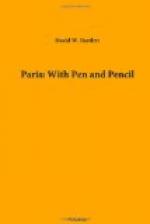Very near the French gallery, there is an alcove in which Henry IV. used often to sleep, and where he at last died. His portrait is now exhibited in it. In another little recess the suit of armor which Henry II. wore on the day of his death, is shown to the stranger. It was in the year 1559. The day was very hot and the king let down his helmet for fresh air. The royal party were engaged in a tournament, when the tilting-spear of the count de Montgomerie pierced the king’s eye, and through it his brain, and he died.
The Spanish gallery contains many fine specimens of the works of the Spanish masters, Velasquez, Murillo, and others.
The Standish Collection is so called, because it was given to Louis Phillippe in 1838, by an Englishman by the name of Standish. It includes many first-class paintings, and a bible once owned by Cardinal Ximenes, now valued at twenty-five thousand francs. Before Louis Phillippe died, he claimed this collection as his private property. He had no intention of taking it away, but wished to test his claim to it. It was acknowledged, and he then bequeathed it to the Louvre.
It is impossible for me in a brief sketch to even mention all the apartments in the Louvre, and I must pass by many. The upper floor is devoted to a Marine museum. It contains fourteen rooms, all well-filled with curiosities. Among them I noticed some excellent models of brigs, ships, men-of-war, Chinese junks, etc. There is in this suite of rooms a fine display of American curiosities. It first struck me that Colton’s collection must be before me, but I soon discovered my mistake.
The Louvre contains a spacious museum of antiquities beneath the painting-galleries. There is also a museum of modern sculpture on the ground-floor. It contains the finest specimens of French sculpture, as well as the master-pieces of foreign sculptors. In the first room there is one of Michael Angelo’s best pieces—the Master and his Slave. It is, indeed, a master-piece. One of Canova’s pieces—a Cupid and a Psyche—thrilled me with its exceeding beauty.
But I must say a few words respecting the building of the Louvre. The eastern facade is one of the finest specimens of architecture that any age can boast. The colonnade is composed of twenty-eight Corinthian columns. There is a gallery behind them in which you may promenade, looking out upon the streets below. The southern front of the Louvre, seen from one of the bridges of the river, with its forty Corinthian pilasters and sculptures, is a magnificent sight.
The building of the Louvre forms a perfect square, and after visiting the different galleries, the stranger will find that he has completed the circuit. The gateways are fine and richly ornamented with sculptures, and the court is a pleasant one. Each side of the building measures four hundred and eight feet.




